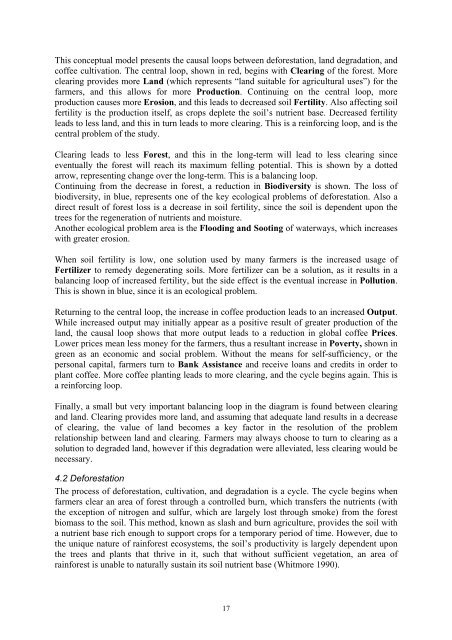Deforestation, Coffee Cultivation, and Land Degradation ... - lumes
Deforestation, Coffee Cultivation, and Land Degradation ... - lumes
Deforestation, Coffee Cultivation, and Land Degradation ... - lumes
You also want an ePaper? Increase the reach of your titles
YUMPU automatically turns print PDFs into web optimized ePapers that Google loves.
This conceptual model presents the causal loops between deforestation, l<strong>and</strong> degradation, <strong>and</strong>coffee cultivation. The central loop, shown in red, begins with Clearing of the forest. Moreclearing provides more L<strong>and</strong> (which represents “l<strong>and</strong> suitable for agricultural uses”) for thefarmers, <strong>and</strong> this allows for more Production. Continuing on the central loop, moreproduction causes more Erosion, <strong>and</strong> this leads to decreased soil Fertility. Also affecting soilfertility is the production itself, as crops deplete the soil’s nutrient base. Decreased fertilityleads to less l<strong>and</strong>, <strong>and</strong> this in turn leads to more clearing. This is a reinforcing loop, <strong>and</strong> is thecentral problem of the study.Clearing leads to less Forest, <strong>and</strong> this in the long-term will lead to less clearing sinceeventually the forest will reach its maximum felling potential. This is shown by a dottedarrow, representing change over the long-term. This is a balancing loop.Continuing from the decrease in forest, a reduction in Biodiversity is shown. The loss ofbiodiversity, in blue, represents one of the key ecological problems of deforestation. Also adirect result of forest loss is a decrease in soil fertility, since the soil is dependent upon thetrees for the regeneration of nutrients <strong>and</strong> moisture.Another ecological problem area is the Flooding <strong>and</strong> Sooting of waterways, which increaseswith greater erosion.When soil fertility is low, one solution used by many farmers is the increased usage ofFertilizer to remedy degenerating soils. More fertilizer can be a solution, as it results in abalancing loop of increased fertility, but the side effect is the eventual increase in Pollution.This is shown in blue, since it is an ecological problem.Returning to the central loop, the increase in coffee production leads to an increased Output.While increased output may initially appear as a positive result of greater production of thel<strong>and</strong>, the causal loop shows that more output leads to a reduction in global coffee Prices.Lower prices mean less money for the farmers, thus a resultant increase in Poverty, shown ingreen as an economic <strong>and</strong> social problem. Without the means for self-sufficiency, or thepersonal capital, farmers turn to Bank Assistance <strong>and</strong> receive loans <strong>and</strong> credits in order toplant coffee. More coffee planting leads to more clearing, <strong>and</strong> the cycle begins again. This isa reinforcing loop.Finally, a small but very important balancing loop in the diagram is found between clearing<strong>and</strong> l<strong>and</strong>. Clearing provides more l<strong>and</strong>, <strong>and</strong> assuming that adequate l<strong>and</strong> results in a decreaseof clearing, the value of l<strong>and</strong> becomes a key factor in the resolution of the problemrelationship between l<strong>and</strong> <strong>and</strong> clearing. Farmers may always choose to turn to clearing as asolution to degraded l<strong>and</strong>, however if this degradation were alleviated, less clearing would benecessary.4.2 <strong>Deforestation</strong>The process of deforestation, cultivation, <strong>and</strong> degradation is a cycle. The cycle begins whenfarmers clear an area of forest through a controlled burn, which transfers the nutrients (withthe exception of nitrogen <strong>and</strong> sulfur, which are largely lost through smoke) from the forestbiomass to the soil. This method, known as slash <strong>and</strong> burn agriculture, provides the soil witha nutrient base rich enough to support crops for a temporary period of time. However, due tothe unique nature of rainforest ecosystems, the soil’s productivity is largely dependent uponthe trees <strong>and</strong> plants that thrive in it, such that without sufficient vegetation, an area ofrainforest is unable to naturally sustain its soil nutrient base (Whitmore 1990).17
















